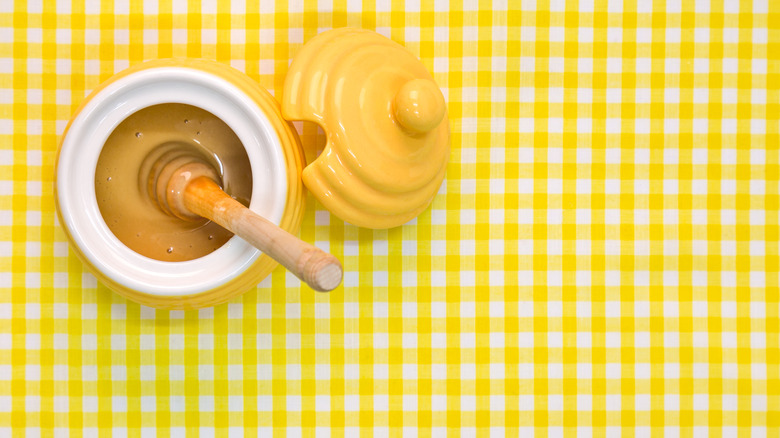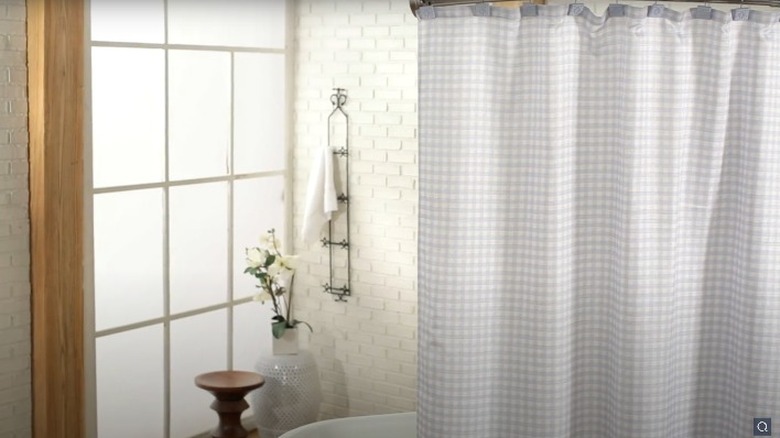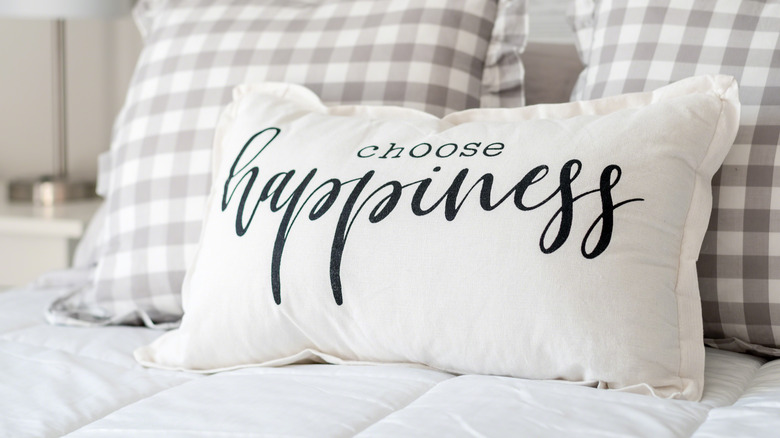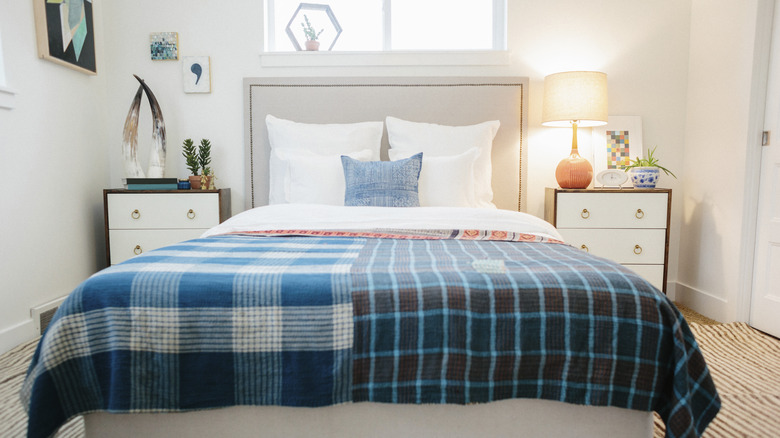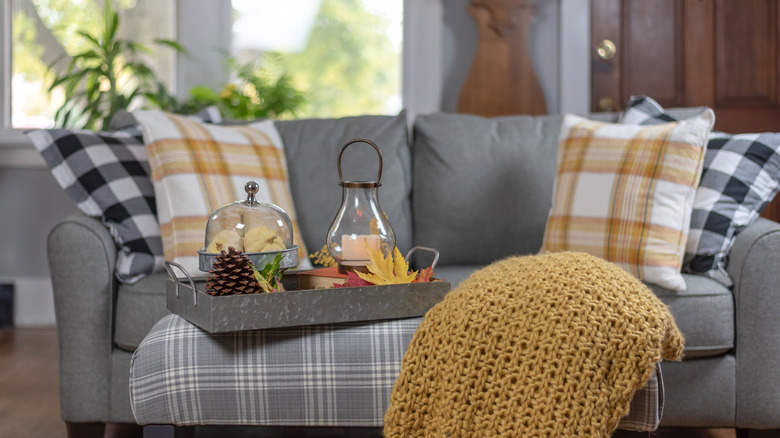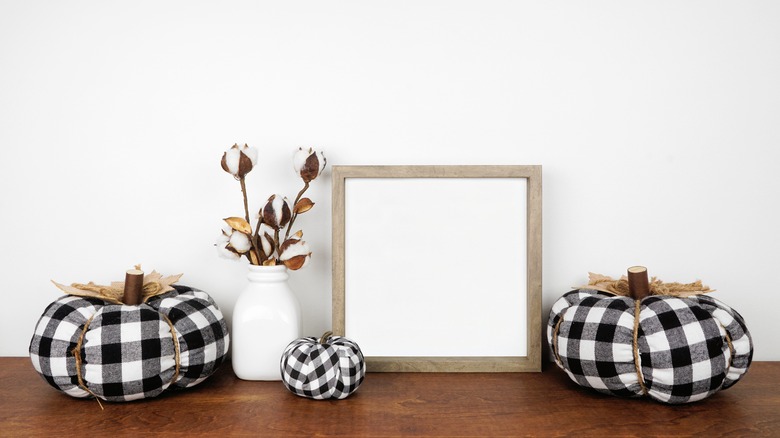5 Tips For Perfectly Styling Gingham
Long considered the preferred pattern of tablecloths and diner curtains, gingham has slowly inched back into popularity in American homes, cropping up in a number of design schemes. Coming in all colors, dimensions, and types of fabric, this versatile print is often mistaken for plaid according to Design Pool Patterns. The difference lies in the number of colors used in the pattern. Gingham usually employs a more limited palette of two to three shades, often white with one or two shades (lighter or darker) of a single color. Plaids employ more colors, stripes, and less regular patterning.
The uptick in gingham's popularity can surely be tied to the rise of cottagecore and modern farmhouse decor, which often make use of gingham, either in its traditional variations of red, blue, and yellow, or in staid neutrals that complement more minimalist design schemes. When considering adding gingham as a design element, on a large or small scale, there are a number of key things to think about regarding placement, size, and color that will help keep your style looking fresh and modern.
Placement
Kitchens are often the first place homeowners think to add gingham. It's a pattern that evokes picnic blankets and old-school café curtains, after all. To incorporate it into your own kitchen, keep an eye out for curtains, napkins, and dishtowels in gingham prints of all sizes.
While the kitchen is a great place to add the style, it's also a pattern that can be used almost anywhere. According to Vox, the popularity of gingham in American kitchens began to rise in rural areas in the early 20th century, then exploded into clothing design after the appearance of Dorothy's famous blue checked dress in "The Wizard of Oz."
These days, a shower curtain in a large-scale gingham print is a great way to add pattern in a smaller space. Wide-patterned ginghams work well for upholstered pieces, drapery, and bedspreads. Consider smaller touches of gingham on throw pillows or blankets. The print is also available in non-fabric decor options like vases, lampshades, and other accent pieces for the home.
Color
Gingham is versatile, coming in shades that complement every season of the year. While pale blue and navy ginghams scream summer, more earthy tones and neutrals are perfect for fall or winter. Many vintage-inspired ginghams appear in traditional colors like pale blue and soft pink, however, ginghams can also be found aplenty in shades like gray, taupe, caramel, and black. If you are looking for a way to add pattern and texture to a strictly neutral room, consider adding gingham pieces in a similar color pattern. Designers at Modsy suggest choosing a high-contrast gingham like black or navy on white for an instant elevation of sophistication in your space.
For more colorful cottagecore design schemes, opt for vintage-inspired patterns in pale blue and yellow in various sizes. Or, outfit your country kitchen in traditional red and white checks. Red gingham also works for a secluded Italian restaurant feel. Just add a candle in a chianti bottle and you're all set.
Scale
Gingham patterns come in a variety of scales and sizes, from the tiniest checks that clock as neutrals from a distance to more obvious large-squared patterns. While smaller ginghams may seem busy and overwhelm some spaces, larger gingham patterns can be a perfect compromise between solids and prints. The wider stripes and blocks of color entertain the eye without overwhelming it.
Smaller ginghams are great for pops of pattern, but very small squares can also give the illusion of a solid, so they may be perfect on larger pieces like sofas and chairs where they won't get too busy. In addition, tiny gingham looks perfect paired with other size variations on this popular pattern, offering a sense of contrast and texture without drawing too much attention to itself. Mansion Global has a tip for anyone feeling reluctant about incorporating patterns. Consider a smaller scale print on a single item of furniture like a bench or ottoman.
Mixing prints
If you love mixing patterns in your home, gingham is an excellent option alongside other decorative styles like plaids, florals, and stripes. This type of pairing works well in both neutral-toned and more colorful design schemes. Varying the size and scale of prints forms a lovely variation that complements the other style. Gingham goes particularly well with more complicated plaid patterns in similar or complementary color combinations. According to The Coastal Oak, a large number of gingham prints in fresh, contemporary colors can be found in abundance at many retailers.
Consider layering throw pillows and blankets in a mix of matching colors on a sofa or bed. Gingham gives off a cozy vibe that is only augmented by other plaids and florals, particularly stylish in the fall and winter. In summer, pair softer toned gingham prints with ticking stripes that are perfect for farmhouse, cottage, or coastal decor schemes. Gingham also makes a great pattern on larger items like rugs.
Accent pieces
If you are looking for ways to bring gingham into your home but aren't sure you want to add large pieces, consider small accents in the popular checked pattern. With its rising popularity, a number of items, including placemats, lampshades, and seasonal decor pieces can now be readily found. Black and white gingham pumpkins have been a stylish alternative to the classic orange for several years, giving a country and farmhouse vibe to traditional fall decor seeming too Halloween-ish in feel. According to Kelly in the City, making cute DIY versions of this trend is a fun fall project and requires only a few supplies.
Forest green and red gingham elements can be added to Christmas decor. Pastel ginghams are a perfect addition to spring and Easter tables. Navy and lighter blue ginghams offer a lovely nautical feel to summery coastal themed rooms. Whatever your design style, gingham is a great element to add a little or a lot of.
